Cream Pitcher People - A Collection
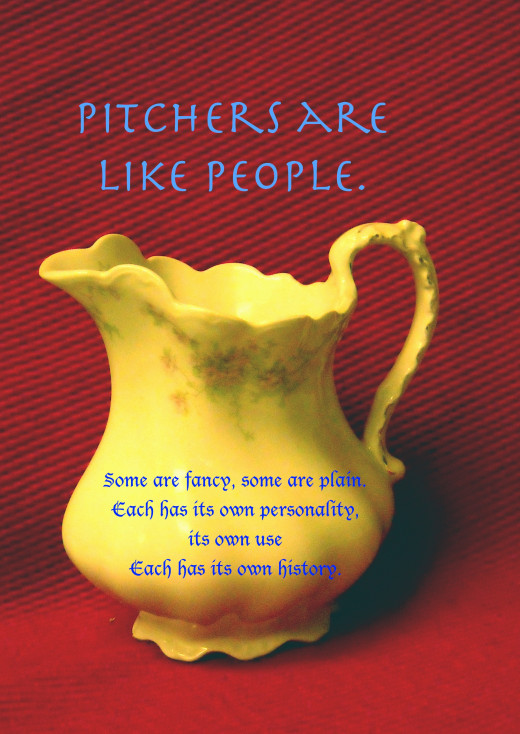
People Are Like Pitchers
They come in different sizes , colors and shapes. They might be attractive or homely, elegant or plain. They can also be helpful, practical and useful, no matter what their style.
Both pitchers and people are often defined by what is inside of them, and by what pours from their lips.
I didn't intend to start a pitcher collection. I'm not really a collector of "things". It started when I was about 12 years old while with my grandmother who was sorting through some boxes she had stored away.
She was deciding what she should keep and what she should get rid of because she was moving into a small apartment.
She pulled out a white cream pitcher with scalloped edges that was decorated with petite nosegays of pale pink flowers. I admired it and she gave it to me.
I kept it on a shelf in my room in a small bowl that reminded me of the old-fashioned pitcher and basin of the Victorian era. Nana, born in the last of that era, had a whole set of the fancy dishes, though I don't really remember her using them.
My grandparents didn't have a lot of fancy belongings. They moved often and had minimal possessions of any kind. The generous, old-fashioned pitcher still reminds me of her.
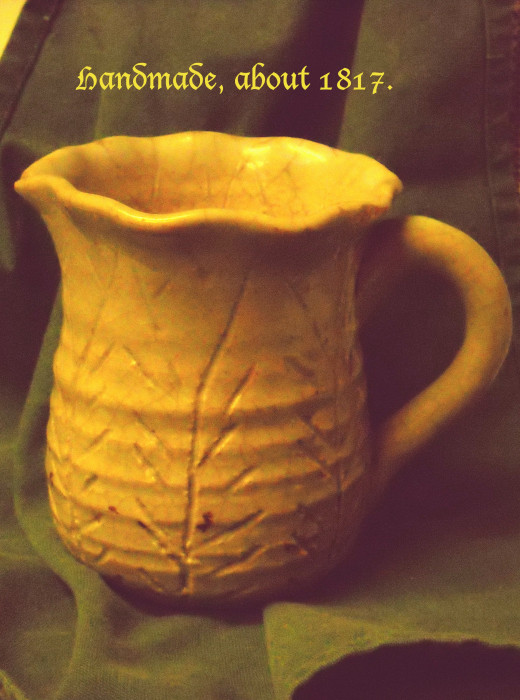
My oldest pitcher has an even longer family history.
Made in Poland in about 1817, it traveled with my mother's ancestors through Russia, Germany, Brazil and the USA.
It belonged to the family of my great grandmother, who took the same trip as the pitcher.
She was born in 1844, so it probably belonged to her mother.
It is about four and a half inches high and three inches in diameter. It is a thick-walled stoneware with a muddy gray glaze and a hefty handle.
It was made with a quality of lasting sturdiness that took precedence over esthetics or ergonomics.
It is obviously hand made, with a crude decoration scratched into the clay.
A homely piece of folk art, it apparently survived many hard times and many travels in making its way from a peasant's home in Europe to a modern house in California.
It sits unabashedly among finer, thinner, more elegant pitchers, and says much about the hardy, humble roots of my family.
Grandma D's Cream Pitcher
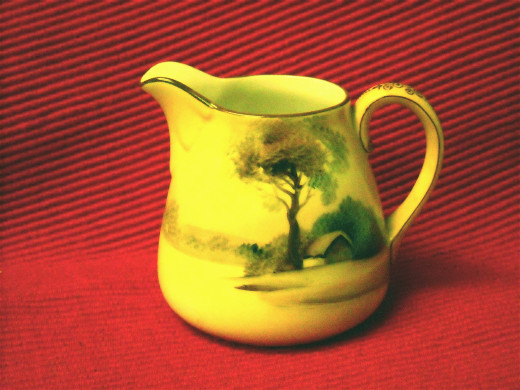
I also have a cream pitcher from my maternal grandmother.
It is one of my favorites because of its sunny color with the detailed and serene landscape scene. The tiny cottage appears to have a thatch roof like those typical to the countryside of northern Europe.
On the bottom it says "Hand Painted in Japan" and dates back to sometime in the 1920s, I think.
I never really knew this grandma, since she died when I was just a little over a year old. She was relatively young, in her early fifties, and I know that her passing was a very great loss for my mom.
Everyone who ever knew her talked about her kindness and generosity of spirit. For me, the peaceful scene is a connection to her spirit.
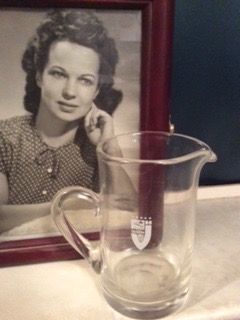
The little clear glass pitcher, marked with a coat of arms, stenciled on it does not have the strong family connection that some of the others do, but is does bring a family story to mind.
The incident occurred when my parents were traveling in Yugoslavia. American tourists were rather rare in that country at that time, and hotel personnel were apparently not aware of the peculiar custom of some tourists who like to enjoy a mixed drink with ice in it. Dad politely asked if room service could bring some ice to their room so they could enjoy a cocktail.
Mom said the ice, which arrived in this tiny pitcher (barely four inches tall) looked like it had been scraped off of someone's roof.
She kept the pitcher and later gave it to me. I suppose I could be prosecuted for receiving stolen goods, but since Yugoslavia has now been broken into several countries, I'm not sure where to return it.
From The Colony Glassblower
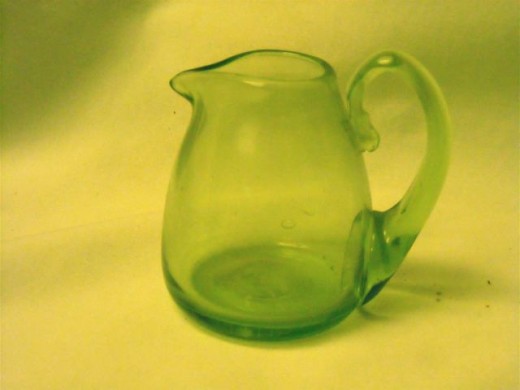
In Jamestown Virginia, we watched the glass blower make bottles and jars, and little cream pitchers out of green-tinted glass.
Glassmaking was an early industry in the old colony of Virginia, and the costumed re-enactors, plied the old trade of bottle making in the old manner, to show the tourists how it was done.
I still have my little pale green pitcher that looks as if it might have been made in the days of the old colony.
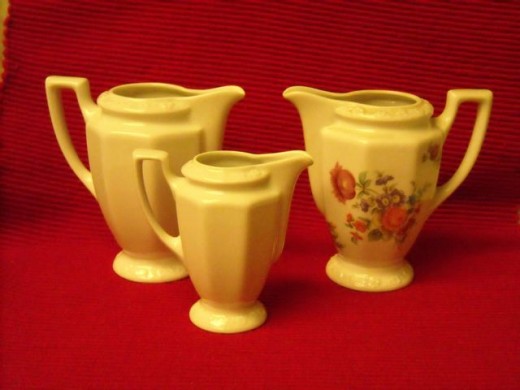
The three graceful Rosenthal pitchers were brought from Germany by my husband's cousins . They probably cost more than all of the others I have. Two are plain white and the other has a flower pattern. Apparently someone told her that I collected such things, and she gave them to me as a gift when they came to visit us in California.
Mom painted the little flower-bud pitchers in a ceramics class she took. She always carved her name or initials and the date on the pieces she made.
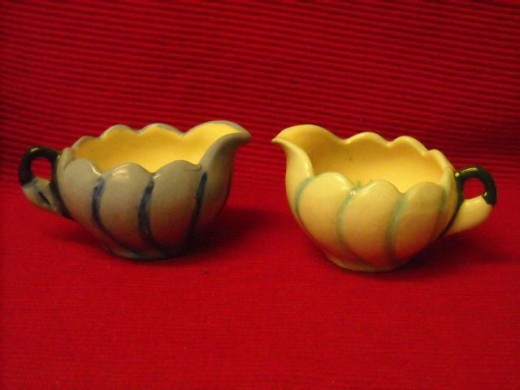
I have other pitchers. My aunt's milk glass cream pitcher were given to me by my cousin after her mom passed away. It is carefully cast with a rigid and geometrically regular pattern. It hold a generous cup of cream.
She collected pieces of this kind of glass-- though I always thought of it as being not at all like the creative, imaginative and somewhat disorderly woman she was.
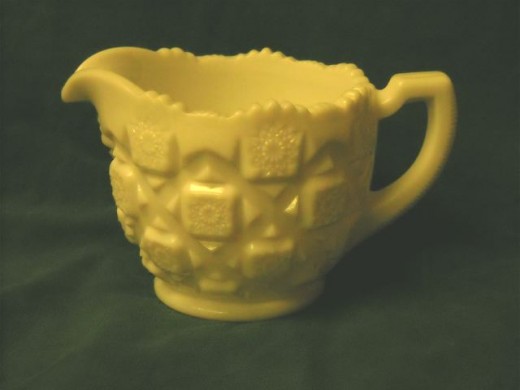
Some people are like lemonade pitchers that bring cooling refreshment when you are are thirsty and exhausted.
Some are like wine jugs that add a friendly and comfortable ambience to a sociable meal.
Some can be vinegar cruets that usually pour forth a sharp sour piquancy that can only be taken in small doses.
Then there are the cream pitchers that add a rich smooth sweetness in just the right quantity. Most of my pitchers are cream pitchers.
Each pitcher and each person has a history of where they came from, what made them the way they are, and in what ways they are best suited to serve.
Each pitcher and every person seems to have a particular personality. Some are multi-functional, pouring out different moods or tastes at various times.
Some are plain, some fussy. They can be transparent, or elegant; fragile or hefty.
Some of them are a little cracked or crazed.
Some are plastic.








